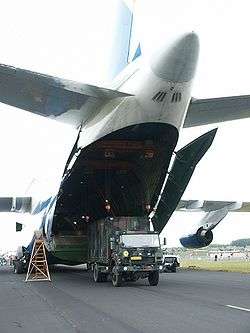Gilze-Rijen Air Base
Gilze-Rijen Air Base Vliegbasis Gilze-Rijen (Advanced Landing Ground B-77) | |||||||||||||||
|---|---|---|---|---|---|---|---|---|---|---|---|---|---|---|---|
|
Antonov An-124 being loaded at Gilze-Rijen in 2005 | |||||||||||||||
| IATA: GLZ – ICAO: EHGR | |||||||||||||||
| Summary | |||||||||||||||
| Airport type | Military | ||||||||||||||
| Owner | Military of the Netherlands | ||||||||||||||
| Operator |
Royal Netherlands Air Force (RNLAF) Koninklijke Luchtmacht (KLu) | ||||||||||||||
| Location | Gilze en Rijen, Noord-Brabant, Netherlands | ||||||||||||||
| Built | 1910 | ||||||||||||||
| Elevation AMSL | 15 m / 49 ft | ||||||||||||||
| Coordinates | 51°34′02″N 004°55′54″E / 51.56722°N 4.93167°ECoordinates: 51°34′02″N 004°55′54″E / 51.56722°N 4.93167°E | ||||||||||||||
| Website | www.luchtmacht.nl/gilzerijen/ | ||||||||||||||
| Map | |||||||||||||||
 EHGR Location of Gilze-Rijen Air Base | |||||||||||||||
| Runways | |||||||||||||||
| |||||||||||||||
Gilze-Rijen Air Base (Dutch: Vliegbasis Gilze-Rijen, IATA: GLZ, ICAO: EHGR) is a military airbase in the Netherlands located between the cities of Breda and Tilburg, in the Noord-Brabant province. It is mainly, but not exclusively used as a base for attack helicopters. The airfield has two runways, the longest, complete with instrument landing system (ILS) is 2,779 metres (9,117 ft) long by 45 m (148 ft) wide in the 10/28 direction. The shorter runway (without ILS) is 1,996 m (6,549 ft) by 30 m (98 ft) in the 02/20 direction.
History
Gilze-Rijen Air Base is one of the oldest airfields in the Netherlands, the first aircraft to have landed there being a Blériot in 1910. The first military aircraft activity dates back to 1913, when a Farman aircraft used the field for military exercises which established it as a military airfield.

In 1940, the airfield came under heavy attack from the German Luftwaffe, who later took control of the base and expanded it for their own use. While in German hands during the Second World War, the field came under frequent attack from allied forces until the liberation of the south of the Netherlands, after which the British Royal Air Force took control of the airfield.
In 1946, the Royal Netherlands Air Force (RNLAF) resumed operations from the airfield, using it as a training base for pilots and air traffic controllers. In 1962, training activity was suspended, and Gilze-Rijen was reduced to a reserve base for bomber aircraft. Training activity was resumed in 1967 however. In 1971, the training activity was suspended again when a fighter squadron was moved to the airfield, which also included a significant upgrade of airport facilities. Initially the Northrop NF-5A/B, and later its replacement, the General Dynamics F-16A/B Fighting Falcon, were operated from the base up until 1995. It has 30 Hardened Aircraft Shelters (HAS).
In 1995, as a part of a large scale reorganisation within the Royal Netherlands Air Force, the fighter aircraft were moved from Gilze-Rijen, and instead the base became the home of Bolkow BO-105 helicopters. In 1998, AH-64 Apache attack helicopters followed, while the BO-105 helicopters were slowly being phased out.
In 2009, helicopter operations from Soesterberg Air Base were moved to Gilze-Rijen Air Base, which resulted in CH-47 Chinook and AS 532U2 Cougar Mk 2 helicopters being based at the airfield as well as the Alouette III for VIP transport, making Gilze-Rijen the main operating base for military helicopters in the Netherlands.
Stichting Koninklijke Luchtmacht Historische Vlucht
The Stichting Koninklijke Luchtmacht Historische Vlucht (Royal Air Force Historic Flight Foundation) is also located at Gilze-Rijen air base, owning and operating a collection of mainly historic military aircraft. The currect fleet consists of the following aircraft:
- Auster Mk.III
- Beech T-7 Navigator
- Cessna 172P Skyhawk (for training purposes)
- de Havilland 82A Tiger Moth
- de Havilland Canada DHC-2 Beaver
- Fokker S-11 (4x)
- Fokker F-27
- Noorduyn Harvard IIb (6x)
- North American B-25 Mitchell
- Piper Cub (5x)
- Ryan ST-M
- Stinson Voyager
- Supermarine Spitfire Mk.IX
Units
- 298 Squadron CH-47D/F Chinook (includes Vlucht 5, 5 Flight, conducting special operations). Squadron was formed in 1950 at as the successor to 6 ARVA (6e Artillerie Verkennings Afdeling or 6th Artillery Reconnaissance Section), flying Austers.[3] From 1968 it was at Soesterberg flying the SA 316.
- 299 Squadron (Training and Standards)
- 300 Squadron Eurocopter AS 532U2 Cougar Mk 2 and Aérospatiale Alouette III
- 301 Squadron AH-64D Apache
- 604 Reserve Squadron (partial)
- 670 Security Squadron
- 930 Maintenance Squadron
- 931 Support Squadron
- 932 Logistics Squadron
See also
References
- ↑ Airport information for EHGR at World Aero Data. Data current as of October 2006.Source: DAFIF.
- ↑ Airport information for GLZ at Great Circle Mapper. Source: DAFIF (effective October 2006).
- ↑ Scramble, 298 Squadron
External links
| Wikimedia Commons has media related to Gilze-Rijen Air Base. |
- (Dutch) Luchtmacht.nl - Vliegbasis Gilze-Rijen, official website
- Royal Netherlands Air Force Historical Flight Foundation
- Airliners.net - Photos taken at Gilze-Rijen Air Base
- Current weather for EHGR at NOAA/NWS
- Accident history for GLZ at Aviation Safety Network
